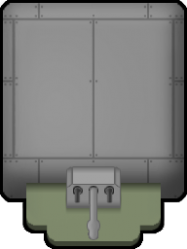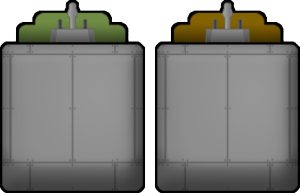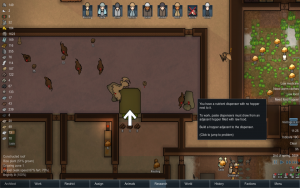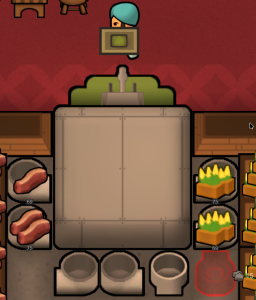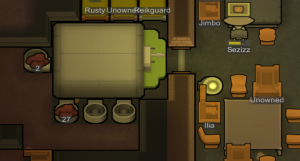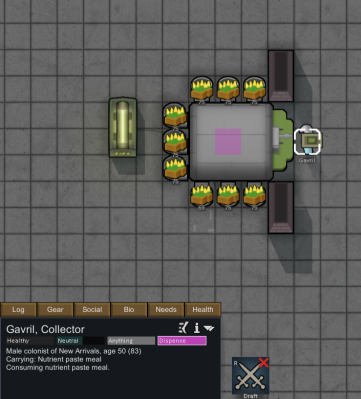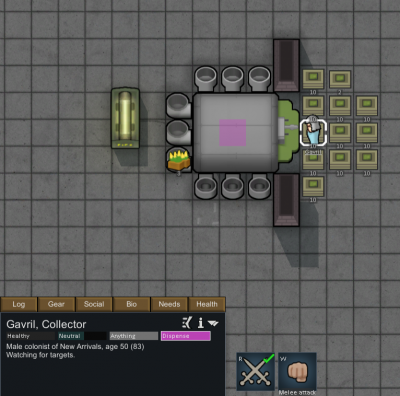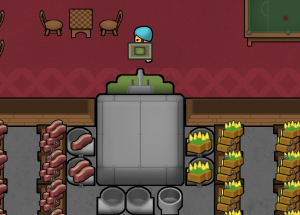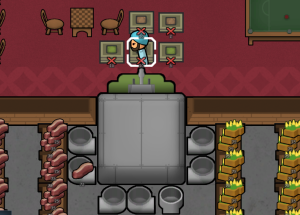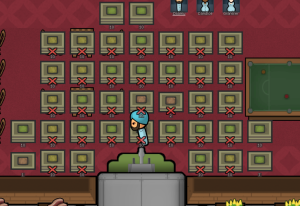Nutrient paste dispenser
Nutrient paste dispenser
A machine that synthesizes edible nutrient paste from organic feedstocks placed in adjacent hoppers. It consumes less ingredients and time than any other meal production method - but nobody likes eating nutrient paste. Accepts raw food, but not rough plant matter like hay.
Base Stats
- Type
- Building – Production
- HP
- 350
- Flammability
- 50%
Building
- Size
- 3 × 4
- Minifiable
- False
- Placeable
- True
- Passability
- impassable
- Cover Effectiveness
- 75%
- Blocks Wind
- True
- Terrain Affordance
- Heavy
- Power
- -200 W
Creation
- Required Research
- Nutrient paste
- Skill Required
- Construction 5
- Work To Make
- 2,200 ticks (36.67 secs)
The nutrient paste dispenser is an electrical device that converts raw food placed in an adjacent hopper into nutrient paste meals.
Acquisition[edit]
Nutrient paste dispensers can be constructed once the Nutrient paste research project has been completed. Each requires ![]() 125 Steel,
125 Steel, ![]() 3 Components, 2,200 ticks (36.67 secs) of work modified by the construction speed of the builder, and a construction skill of 5.
3 Components, 2,200 ticks (36.67 secs) of work modified by the construction speed of the builder, and a construction skill of 5.
Once constructed, they cannot be re-installed, they can only be deconstructed.
By default, New Arrivals start with nutrient paste researched.
Summary[edit]
This section is a stub. You can help RimWorld Wiki by expanding it. Reason: Describe what happens when nutrition of individual feedstock item exceeds required nutrition (Note: see below for order of hopper draw when testing):
|
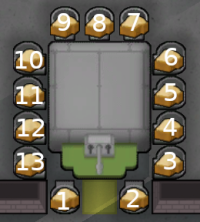
Gold tile is the interaction spot. Numbers indicate order the hoppers will be drawn from - Note that this order is not rotated if the dispenser is.
The nutrient paste dispenser is an impassible object, acting like a wall for room and temperature mechanics. Pawns will dispense meals from the interaction spot, the front-center tile indicated by the circle during placement. If this spot is inside a prison cell, then the machine will change color to orange and only prisoners will be allowed to use it. You cannot build objects on the interaction spot, nor can you build the dispenser with it blocked. Chunks placed there after construction will prevent use until they are hauled away.
The dispenser creates ![]() 1 nutrient paste meal for 0.3 nutrition worth of food placed in an adjacent hopper. Hoppers can be placed in any cardinally adjacent tile, except for the interaction spot. The dispenser will attempt to draw food from the southwesternmost hopper first, regardless of dispenser orientation. If insufficient food is present in this hopper, then it will be emptied of any food inside, and then the process is repeated on each hopper proceeding counterclockwise around the dispenser until sufficient food has been collected to make a meal or all hoppers have been checked. If there is insufficient food to make a meal in all of the attached hoppers, no food will be consumed and no meal will be produced.
1 nutrient paste meal for 0.3 nutrition worth of food placed in an adjacent hopper. Hoppers can be placed in any cardinally adjacent tile, except for the interaction spot. The dispenser will attempt to draw food from the southwesternmost hopper first, regardless of dispenser orientation. If insufficient food is present in this hopper, then it will be emptied of any food inside, and then the process is repeated on each hopper proceeding counterclockwise around the dispenser until sufficient food has been collected to make a meal or all hoppers have been checked. If there is insufficient food to make a meal in all of the attached hoppers, no food will be consumed and no meal will be produced.
Nutrient paste dispensers can share hoppers, the direction of the hoppers is only visual.
Colonists will deliver food as both Hauling and Cooking tasks. Make sure to set the Priority of the hoppers to be higher than other stockpiles. Only one type of food can be placed into each hopper. Any food except hay will be used, including corpses, but colonists will only load it with raw food. It is possible to force other foods on top of a hopper by taking it to a pawn's inventory and then manually dropping it in front of the hopper. This may be considered an exploit.
Colonists or prisoners will automatically use the dispenser any time they would otherwise look for a meal to pick up and eat, assuming it is powered, accessible, has enough food, the pawn is allowed to eat nutrient paste meals per their Food restrictions and there are no preferable unrestricted meals available. No work bills or tasks can be performed at the machine, and no skills are necessary to use it. Wardens can also deliver nutrient paste from an external machine to prisoners, and Doctors will do the same for patients. Doctors can use prison-designated dispensers to feed prisoner patients. Animals cannot operate the dispenser but will eat meals if provided. In order to produce meals for storage or animals, you must manually manipulate a pawn - see below for details.
Nutrient paste[edit]
Nutrient paste converts 0.3 nutrition of raw food to a 0.9 nutrition meal, tripling your food. But when consumed, nutrient paste gives a −4 mood penalty ("Ate awful meal"). This is at least better than eating raw food. Pawns will always prefer a more tasty food, so unless their Food Restriction is specifically assigned to "Paste" (located at the top of a colonist's Health tab), they will only use the dispenser if no better option is available. The mood penalty is negated if the colonist eating it has the Ascetic trait, or the Eating Nutrient Paste: Don't mind precept in their ideoligion![]() .
.
Use of human meat, insect meat, twisted meat![]() or, if the Ideology DLC is enabled, raw fungus, in a nutrient paste meal will still apply their regular moodlets, on top of the one for nutrient paste.
or, if the Ideology DLC is enabled, raw fungus, in a nutrient paste meal will still apply their regular moodlets, on top of the one for nutrient paste.
Analysis[edit]
At 300% nutritional efficiency, Nutrient paste is the most efficient way to prepare a meal. Compared to the next best method, simple and fine meals with 180% efficiency, paste gives 66.67% more food. This makes nutrient paste useful in a famine, even if you don't plan to use it indefinitely. In addition, no cooking is necessary. There's no risk of food poisoning, and it can save a lot of time off a cook's hands - cooking is often a full time job in large colonies. Overall, a nutrient paste dispenser can accelerate the development of a colony, and may be necessary in an extreme biome like ice sheet.
However, nutrient paste meals give a −4 mood debuff, which ends up being -9 net mood compared to fine meals. It is advised to not give nutrient paste to pawns with a trait that gives a negative modifier to mental break threshold, because they can push a pawn over the edge. Because pawns prefer normal meals over nutrient paste, you can set restrictions to prevent normal pawns from consuming all of the good meals and leaving none to the volatile ones. In contrast, Ascetics can eat paste without worry.
Transhumanist, Inhuman![]() , and Shipborn
, and Shipborn![]() ideoligions
ideoligions![]() can eat these meals without penalty, but still miss out on +5 mood from fine meals. Due to the increased hunger from using neural superchargers and sleep accelerators, a paste dispenser may be preferred.
can eat these meals without penalty, but still miss out on +5 mood from fine meals. Due to the increased hunger from using neural superchargers and sleep accelerators, a paste dispenser may be preferred.
- Notes
The dispenser has a minor quirk - because colonists have to dispense meals as needed, they will never carry meals in their inventory. By preventing outdoor snacking, it forces colonists to eat at a nearby dining area, always giving the <Impressive> dining room moodlets while preventing −3 Ate without Table. However, this makes colonists slightly less efficient, as they'll have to travel to the dispenser every time they want to eat. It's also worth noting that having hoppers filled with food in the dining room will cause the room to count is a "Storeroom" which will stop pawns from receiving the positive dining room moodlet. If the hoppers are empty the room will count as a "Dining room".
The paste dispenser also makes it a lot easier to keep animals that need to be fed by the colonists (such as dogs and grazing animals off the growing season). Feeding animals with paste requires occasional micro-management to create meal reserves, since animals cannot trigger the dispenser themselves.
Throne rooms[edit]
| This section relates to content added by Royalty (DLC). Please note that it will not be present without the DLC enabled. |
With Royalty active, it is possible to combine a throne room with a dining room. However, nutrient paste dispensers count as a "Production" building, and are not allowed in the room. Having the NPD very close is still possible, even as close as one door away.
Manually producing meals[edit]
Using the paste dispenser is an automatic task that cannot be explicitly triggered. It is still possible to make a pawn produce as many meals as you want, until the machine runs out of raw food to process.
You need at least one pawn to be hungry enough to demand a meal. This will happen at least once per day, per pawn.
Forcing the pawn to create meals exploits the fact that a pawn stops their current action when they are drafted. We also need to keep the colonist away from any food, so they will be forced to keep producing new meals at the paste dispenser.
Method 1: using a special zone restriction (recommended)[edit]
The following method uses a 1-tile zone restriction that is placed in the middle of the dispenser. This is the easiest method for producing more than one stack of meals at a time. In detail:
- Create a new area that covers exactly 1 tile in the center of the main body of the nutrient paste dispenser (as shown in the screenshot). The exact location of this area matters, in order for the pawn to be able to path to the paste dispenser.
- When one of your colonists (it does not matter which one) becomes hungry, and is about to eat a meal, pause the game and restrict the pawn to the area created in step one. You might also have to draft and undraft the colonist so he will stop the current action. The pawn will now be unable to do anything except produce meals at the paste dispenser, due to the zone restriction he is now under. He will even be unable to grab meals that are right on top of him, including the ones he produces from the machine!
- Wait for the colonist to walk up to the paste dispenser and draw a meal from the machine. Pause the game again at this point.
- To start mass producing meals, simply draft and undraft the pawn as many times as desired. Each cycle will instantly procure another meal from the dispenser, using up some of the resources from the hoppers. The meal is not consumed by the colonist, because drafting him will make him drop the meal on the floor, where it will be out of reach (due to the zone restriction). You can hold down the draft hotkey to rapidly mass produce meals.
- When you are finished, simply undraft the pawn a final time and remove the zone restriction from him. Done.
The entire process will require no in-game time, since the game is paused all the way.
Notes:
- If you wait a little to long with pausing the game, after the pawn has produced a meal, they will move away from the dispenser and consume the meal (ignoring the zone restriction). This is not a problem: simply draft and undraft the pawn, they will drop the meal on the ground and you can resume again at step 3 above.
- Pawns may prefer to eat meals that are already made, and not use the paste dispenser in those situations, depending on several factors that are difficult to control. If you want to protect your bulk-produced meals from colonists, you have to forbid the stacks or exclude the colonists from the area they are stored in. Domesticated animals will not eat from forbidden stacks, so an exclusion zone has to be used to reserve the food for animals.
- Many pawns want to eat after getting up in the morning. This makes it easier to watch for hungry pawns if you plan to mass produce some meals.
The pawn is restricted to a 1-by-1 tile wide area which is placed in the middle of the nutrient paste dispenser. The precise location of the zone is important. The pawn will now produce meals indefinitely when drafted and undrafted in front of the dispenser (while there is material on top of the hoppers).
This is the state after all hoppers are depleted. The pawn is now surrounded by stacks of nutrient paste meals. He is still unable to eat any of them, due to the zone restriction (which can now be removed and the pawn undrafted). Note that none of the meal stacks are forbidden, because that is not necessary with this method.
Now you can have as many nutrient paste meals as your heart desires! Enough to take with you on cold journeys! Enough to make an emergency food stockpile! Enough to use as animal fodder!
Method 2: manually forbidding stacks (casual use)[edit]
If you do not want to deal with zone restrictions, you proceed as in method 1, but then you have to forbid any new meal stacks that are created, before continuing to cycle the drafting. This method is a little inconvenient if you want to produce more than a single stack of meals, or if you repeat the process regularly (eg. to produce animal food).
Version history[edit]
- Beta 19/ 1.0 - Now tinted orange when they can be used by prisoners.
- 1.4.3523 - Added build hopper command to nutrient paste dispenser.
